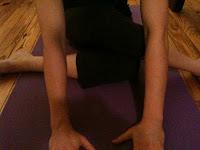While at the CDC, I went to a workshop on behavior change and I’ve been thinking about this for the yoga study. Are we really going to be able to get a group of busy women to start up a yoga practice? It will require creating new habits and new patterns of behavior, and I am wondering if and how that can be taught.
Below are a few of the social science theories discussed that I found useful for thinking about this:
The 11 variables that influence behavior
- Intention to perform a specific behavior
- Environmental factors
- Necessary skills to perform the behavior
- Beliefs about the behavior
- Opinions about consequences or outcomes from the behavior
- Peer pressure
- Self-standards -- how someone wants to perceive themselves
- Emotional reactions towards the behavior
- Perceived self-efficacy -- self-confidence
- Cultural believes
- Contextual factors -- including the “social capital” present in communities such as strong churches, a network of moms, etc… any resources in the community that can be mobilized
Stages of Change
When making behavior change, people go through the following pattern of change:
Pre-contemplation --> Contemplation --> Preparation --> Action --> Maintenance
The “Chain of Causation” in public health
Large scale factors (historical, cultural, political, economic, etc) --> Behavioral Predictors --> Risk behaviors --> Proximate Determinants (pathogens, carcinogens, toxins, etc) --> Disease outcomes.
Medical school focuses us on the last two parts of that chain.
One thing missing from the 11 variables list is the power of good leadership.







